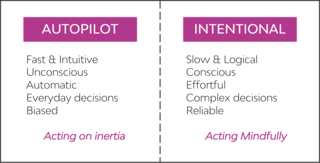Attention
How to Stop Living Life on Autopilot
It's time to turn it off.
Posted November 1, 2018 Reviewed by Davia Sills

Does life just happen to you? Or do you make life happen?
Imagine you just drove home from work. You step out of your car, and I ask you how the trip was. You probably won’t remember how many times you switched lanes or stopped at a traffic light, right? But you got home safe regardless.
When we live on autopilot, it feels like someone else is driving, not us.
Our brains have developed an unconscious decision-making system so we can take care of routine tasks. It prevents us from overloading. However, modern life has hijacked our lives—the mechanism that is supposed to protect us is disengaging us from living.
Ninety-six percent of people in the UK admit to making most decisions on autopilot, according to this research—it has become an epidemic. Our minds are wandering around most of the time.
According to the study, we are living on autopilot in the place where we need to pay the most attention: our home. People make decisions—such as what to eat, what to watch on TV, or what to wear—without putting in any thinking.
Professor Renata Salecl, one of the study contributors, says it better: “We’re forgetting that when we are at home, the important things are to interact with family and friends, without being constantly distracted.”
Most people can’t remember what they watched on TV—additional research shows that binge-watching diminishes memory and perceived comprehension.
What about you?
Five signs you are living on autopilot
1. Your routine is predictable. Your calendar is full of repetitive activities, and you follow your plan without thinking. There’s no room for improvisation or last-minute changes.
2. You are pleasing others. You let other people’s expectations define your choices. You are not paying attention to what you need.
3. You are always on. You never pause to reflect on how you are feeling or what you are doing. You are busy, distracted, or both.
4. You feel time flies. You can’t remember what you did throughout the day. You feel guilty, like you haven’t accomplished much.
5. You believe you are missing out. You know you can have more joy, but you can’t help wandering around.
One exercise I love facilitating to help people reconnect with their life’s purpose is future-self meditation: Participants travel to the future to visit themselves one, three, five, and 10 years from now. The goal is to connect with their dreams and wishes and to understand how they were able to achieve them. To my surprise, many people find it hard projecting into the future—they are so disconnected from the present that they can’t dream.
Living on autopilot disengages us from both our present and our future.
Autopilot Is Not the Only Driving Option
Living on autopilot means leaning towards the most comfortable thinking mode. But we have two; we must learn to use both.
Though System 1 and System 2 have been around for quite some time, it was Nobel awardee Professor Daniel Kahneman’s book, Thinking, Fast and Slow, that turned them mainstream.
"System 1" is an automatic, fast, and unconscious way of thinking—it’s our autopilot. This system is autonomous and efficient, though deceiving too. It’s more prone to bias and repetitive errors.
"System 2" is slow, conscious, and effortful—it requires attention and energy. It’s more reliable and can filter the misjudgments of System 1.

The brain is lazy—that’s why it leans towards System 1. We must be aware and train our mind to avoid living on autopilot.
It’s not that one mode is better than the other—the secret lies in using both in a balanced way.
System 1 is ideal for quick decisions, based on little information. When you are driving your car or doing the laundry, you don’t need to overthink. However, you wouldn’t use it to make more significant life choices, like your career, which home to buy, or who to marry.
System 2 is ideal for handling more complex mental activities, such as logical reasoning, managing interpersonal relationships, learning new things, and building habits. It can help you turn off the autopilot.
So, why should you care?
Get Back in the Driver’s Seat
Being on autopilot has its benefits for mundane activities, such as driving or grocery shopping. However, behaving with intentionality is vital when you must think through a situation, problem, or dilemma.
Choosing which system to use is like getting back in the driver’s seat—you decide when to drive on autopilot and when not.
It’s more comfortable to let life happen to you than making it happen. But if your autopilot is always on, you are just existing, not living.
Here are some tips to get you started.
1. Notice how you drive.
Increase awareness of your behavior. Are you living on autopilot because you want to, or because it just happens? How does it affect your decisions? Are you making choices or merely letting your autopilot choose what show you watch or what food you eat? Write a journal or take notes to increase awareness and challenge your behavior. Be patient. It takes time to recover control of your life.
2. Set your GPS.
What’s your end destination in life? How do you want to be remembered? As the saying goes, “Choose something worth dying for, and live for it.” Your life’s purpose should guide and inspire your actions. When you know what your final destination is, it’s easier to avoid shortcuts or roads that will take you nowhere. Keeping your purpose present will bring more intention to your everyday activities.
3. Bring meaning to your routines.
There’s nothing wrong with using your autopilot—the problem is when it becomes your driving system of choice. Habits drive focus and efficiency. However, they must be connected to your life’s purpose and goals. Don’t let your routines dictate how you live; bring more mindfulness to everyday chores.
4. Stop and reflect.
When you press the brakes, the autopilot turns off. A pause is more than slowing down—it’s creating space to start paying attention. You can reflect on your life. What do you like? Are you enjoying what you are doing? What’s going on? Are you focused or distracted? Why? We are prisoners of our busy minds; pausing sets yourself free.
5. Go beyond your comfort zone.
When we live on autopilot, we stop challenging ourselves—we end up bored and repeating ourselves. Discomfort is a doorway to personal discovery and growth. Learning happens when you stretch beyond your comfort zone. Test your limits. Try new things. Develop the practice of bringing new experiences to your life—you don’t need to skydive to feel alive.
6. Make better decisions.
For simple things, follow your gut (System 1). However, if your gut is not certain, think it through. Avoid cognitive biases—challenge the first solution that comes to mind. Remember, your lazy brain will jump to the most comfortable conclusion, not the best one. Lastly, for important decisions, always think them through.
Share your story. How do you drive?
References
Autopilot Britain - Dr. Mark Williamson & Professor Renata Salecl Whitepaper: Marks and Spencer




